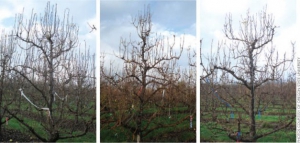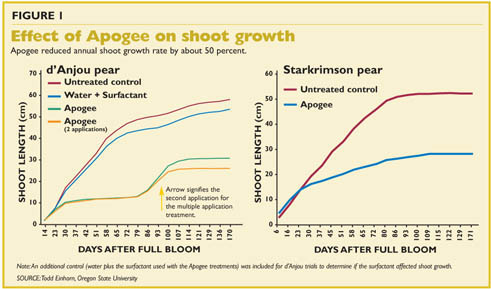
D’Anjou pear trees in the Apogee trial are shown in November 2012. Left tree is untreated, middle received single application of Apogee during the growing season when shoots were two inches long, and right tree received two Apogee applications (second applied when regrowth observed).
Photos courtesy of Oregon State University
• Treatment with Apogee to control vigor
• Root pruning to control vigor and promote fruit set
Apogee
Apogee (prohexadione calcium) is used successfully on apple to manage vigor. Apogee reduces shoot growth by interfering with the plant’s production of the growth-promoting hormone, gibberellic acid. In pear, previous research by Drs. Don Elfvng, David Sugar, and Gene Mielke demonstrated that Bartlett fruit size was directly limited by Apogee in the year of application, while Bosc return bloom and yields were markedly reduced the year following application; d’Anjou fruit growth and return bloom, however, were not similarly affected.
We recently evaluated Apogee on multiple d’Anjou orchards over the past three years. Additionally, we tested Apogee on Starkrimson, given the cultivar’s vigorous growth habit. We consistently observed an approximate 50 percent reduction in the annual growth of shoots relative to untreated trees, irrespective of the cultivar or year. The strongest response occurred when applications were made in early spring when shoots were about 2 inches (5 cm) in length at a rate of 250 parts per million (Figure 1).

In most cases, only one application was required to control d’Anjou shoot growth for the entire season, but in several cases a second application at the same rate was needed about 60 to 80 days after the first. This application coincided with a marked increase in the rate of shoot growth, presumably due to the cessation of activity of Apogee in the plant. Favorable environmental conditions, however, likely play an important role in stimulating this regrowth, since we did not observe it in most years or trials. Starkrimson trees did not require multiple applications of Apogee (Figure 1). In all years, total tree yields of d’Anjou and Starkrimson were either slightly improved on trees sprayed with Apogee or similar to untreated trees (Table 1).

Starkrimson fruit size was unaffected by Apogee; d’Anjou fruit were smaller, though we considered this to be an indirect effect of the significantly higher croploads on Apogee-treated trees. In years when yields were unaffected by Apogee, fruit sizes were equivalent to those of control trees. In the seasons following applications, d’Anjou return bloom was on average 15 percent reduced, but this did not translate to similar reductions in yield. Return bloom of Starkrimson trees was not reduced by Apogee.
In a separate trial, Apogee was applied in early spring to individual d’Anjou shoots of a planar, hedgerow system that were either dormant headed or left unpruned. Strong control of growth was achieved for Apogee-treated shoots, while growth of adjacent untreated shoots, often originating on the same scaffold as their treated counterparts, was unaffected, indicating limited transport within trees. The localized effect of Apogee is notable since it offers the ability to precisely manage portions of the canopy that are imbalanced, such as is often observed with increasing canopy height, or in the tops of trees that have been headed during the dormant season. Apogee was more efficacious when applied to unheaded shoots, but significantly reduced shoot length of headed shoots relative to untreated headed shoots as well. Apogee is not currently labeled for pear.
Root pruning
Root pruning is widely used in Europe to restrict root growth and canopy size in ultra-high-density pear orchards. The practice also promotes return bloom and fruit set in the subsequent year.
We evaluated root pruning on a sixth-leaf trellised planting of d’Anjou on Old Home by Farmingdale 87 rootstocks in which trees had filled their allotted space. Entire rows were root-pruned to a depth of 1.5 feet at a distance of about 1.5 feet from the trunks on one or both sides of the tree row. Shoot length of one-sided and two-sided root-pruned trees was reduced by 20 and 35 percent, respectively, compared to control trees (Figure 2).

Trunk growth, an indicator of total vegetative growth, was similarly reduced over the season; however, yield was reduced by 20 and 40 percent for one- and two-sided root-pruned treatments, respectively, relative to the control.
Fruit size was also reduced by one box size for the root-pruned treatments (size 100) compared to controls (size 90). Given the characteristically low yield potential of d’Anjou in the formative years, a yield sacrifice in the year of treatment is tolerable if trees settle into a bearing mode. Bloom, fruit set, and yield characteristics will be determined in 2013 to assess the utility of root pruning young, established pear orchards.
A second site comprised 30-year-old, widely spaced, freestanding d’Anjou trees on seedling rootstock. Rows were root pruned as previously described, but at a distance of 2.5 feet from the trunks. Tree yield was significantly increased for the two-sided root pruning treatment only. Fruit size was not significantly reduced by root pruning. Vegetative growth was only slightly reduced.
Greater tree and root reserves of older trees after root pruning were likely responsible for the different yield responses between the two orchards.
Additional trial sites (encompassing both young and old trees) will be evaluated next season.

Conclusion
Apogee consistently regulated shoot growth of d’Anjou and Starkrimson pear trees, without accompanying negative effects on fruit size, yield, or return bloom as observed in other cultivars. In fact, strong vegetative growth control was accompanied by improved fruit set in d’Anjou. Root pruning achieved the year-one goal of reducing d’Anjou vigor and controlling tree size; the improved light penetration as a result of reduced vigor needs to result in stronger bloom and/or higher fruit set in 2013 in order for root pruning to be a viable management option.
Other cooperators involved in this research project include Mateus Da Silveira Pasa, Federal University of Pelotas, Brazil; Stefano Musacchi, University of Bologna, Bologna, Italy; and Janet Turner, Oregon State University. Thanks to Herbie Annala for fabricating the root pruner; Gorham Blaine for supplying d’Anjou orchard sites, root pruning and harvest crew; and, Northwest Pear Bureau for funding.
Leave A Comment